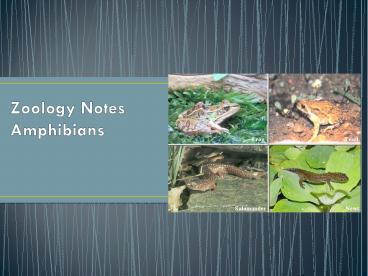Zoology Notes Amphibians - PowerPoint PPT Presentation
Title:
Zoology Notes Amphibians
Description:
Class: Amphibia Author: Jon and Jen ... Thatch 6_Thatch Zoology Notes Amphibians Quick Question #1 Amphibian basics Tied ... Quick Question #3 Life Cycle How do ... – PowerPoint PPT presentation
Number of Views:981
Avg rating:3.0/5.0
Title: Zoology Notes Amphibians
1
Zoology NotesAmphibians
2
Quick Question 1
What are some major evolutionary changes between
fish and amphibians?
3
Amphibian basics
- Definition moist, glandular skin that lacks
scales of reptiles. Complex life cycles. Lay eggs
that are non-amniotic. - The smallest major group of vertebrates
- The transition in evolution from water to land
(amphi means both, bio means life). First
vertebrates to invade the land.
4
Tied to the water
- Larvae are aquatic - gills while adults are
terrestrial - breath through lungs and skin - Eggs have no shells (water prevents drying out).
- Sperm swim through water to fertilize eggs
- Skin must stay moist
5
Not stuck in the water
- Have lungs instead of gills
- Have legs to support body weight
- Improved heart to help deliver needed oxygen to
muscles.
6
Quick Question 2
Explain in your own words how amphibians are the
adapted to land but still need water.
7
Types of Amphibians
- Urodela Salamanders
- Anura Frogs and Toads
- Gymnophiona Caecilians
8
Caecilians (Gymnophiona)
- Legless amphibians
9
Salamanders (Urodela)
- Keep their tails even as adults to aid in
swimming - Some are fully aquatic, some live in moist
environments, some switch back and forth
throughout their life - Can regenerate limbs
10
Frogs and Toads (Anura)
- Frogs have moist, smooth skin and have large hind
legs - Toads have dry, bumpy skin and have short hind
legs
11
Quick Question 3
Quick write everything you know about the life
cycle of a frog
12
Life Cycle
13
How do they eat?
- Tadpoles are filter feeding herbivores
- Adult amphibians are almost entirely carnivorous
- Jaws or long, sticky tongues are used to catch
prey - http//www.youtube.com/watch?vwXqK5QulbJ8
14
Digestion
- Mouth to esophagus to stomach.
- Stomach connects with the small intestine then
large intestine. - At the end of the large intestine is the cloaca,
a muscular cavity that stores wastes until they
are expelled.
15
Respiration
- Through the mouth
- Through the skin
- Through gills or lungs
- Frogs can also pass air through expandable vocal
cords
16
Internal Transport
- Three chambered heart
- Improved heart to deliver more oxygen to walking
muscles. - Tadpoles have a two-chambered heart
17
Quick Question 4
Compare and Contrast a fish heart and a amphibian
heart
18
Excretion
- Use kidneys to eliminate wastes
- Urine travels through tubes called ureters into
the cloaca
19
Response How does it survive?
- Developed nervous system
- Really moveable eyes to detect moving insects
- Ears have no external sound collectors but can
distinguish between calls - Clawless, soft-skinnedso they may be toxic with
warning colors
20
Reproduction
- Oviparous with external fertilization
- Many have internal fertilization and are either
oviparous, ovoviviparous, or viviparous
Amplexus
Male Midwife Toad
Surinam Toad
http//video.nationalgeographic.com/video/animals/
amphibians-animals/frogs-and-toads/frog_greentree_
lifecycle/
http//video.nationalgeographic.com/video/animals/
amphibians-animals/frogs-and-toads/frog_strawberry
poisondart_tadpole/

